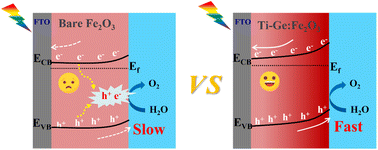The photoelectrochemical (PEC) water oxidation reaction on hematite (α-Fe2O3) photoanodes has certain limitations, especially poor conductivity and rapid carrier recombination. Thus, to address these issues, uniform Ti doping and gradient Ge doping were performed to construct Ti–Ge co-doped hematite (Ti–Ge:Fe2O3). A series of characterization tests showed that uniform Ti doping increased carrier concentration and conductivity, while gradient Ge doping improved charge separation efficiency. Meanwhile, Ti–Ge co-doping in hematite formed a gradient energy band structure, which played a role in improving the charge separation efficiency. The co-doping of other metal elements with Ti was also carried out, which showed significant effects in improving PEC performance. This suggested that Ti:M (M = metal elements) co-doping in hematite to improve its PEC performance is universal. In addition, when the NiFeOOH co-catalyst was loaded on Ti–Ge:Fe2O3, the onset potential negatively shifted by 150 mV and the photocurrent density significantly improved, which was about 9.7 times higher than that of bare Fe2O3. This work provides a novel strategy for improving the PEC performance of hematite via co-doping engineering.
